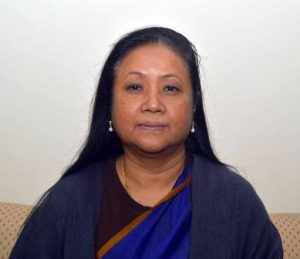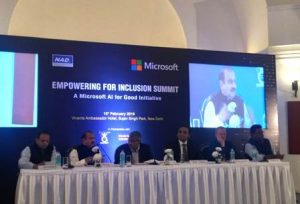Technology as an enabler: Artificial Intelligence for Accessibility
Many disability rights activists and technology entrepreneurs state that AI and cloud technologies can play a decisive role in bringing people of all abilities into the mainstream.

Three years ago, when Siddharth Gautam joined the Indian Railways Department, he was not able to become an active participant in the trainings for the first three months. That is when he decided to ask for a sign language interpreter as he is hard of hearing. “Starting from the initial three months, whenever there was a programme organised, it was inaccessible for me. I fought for an interpreter to be hired and paid for by the Government. While it is Railways’ responsibility to provide the interpreter, I realised it was my responsibility as well to tell them what my needs are. They can only help me when they are aware about my needs,” Gautam shared with Delhi Post saying that while the Northern Railways have started to take measures to provide interpreters, the Southern and Western Railways have not yet taken steps in this direction. “But I always have to ask. I have to keep fighting for it,” lamented Gautam.
This is not only the story of Gautam but millions of people who suffer from different kinds of disabilities, and yet services remain far from being accessible for them. According to World Health Organisation, 15 per cent or 1 billion people of the world’s population suffer from one or other disability. In India, as per the Census 2011 data, 26.8 million or 2.21 per cent constitute People with Disabilities (PwDs). These numbers may not do any justice to the actual ground issues that PwDs face whether in terms of poverty, infrastructure, employment or technology.
Since only one in 10 PwDs get access to assistive technologies, experts point out that basing technology as an enabler and a way forward, especially Artificial Intelligence or making computers think and act like humans can be realised through ‘AI for Accessibility’.
“Accessible and intelligent AI solutions built on recent advancements can help developers create intelligent apps that see, hear, understand and better interpret people’s needs.”
Whether Deque System’s Accessibility Testing Tool; Adobe Acrobat for Accessible Documents; a Video Relay Services for the hearing impaired by Dr. Philip Ray Harper and Microsoft Office 365 for Accessibility, the recently held Microsoft India’s ‘Accessibility Summit 2019 – Empowering for Inclusion’ witnessed assistive technologies developed by leading technology firms and entrepreneurs.
Also read: Taking a leap of ‘Vision’
“Cloud and AI solutions are opening up a world of possibilities, empowering PwDs with tools that support independence and productivity. The summit is a significant step forward in advancing our efforts towards sensitising stakeholders and partners on the business and social value of accessibility. As we continue to learn and grow, we hope to inspire other entities and organisations to build and accelerate their accessibility and inclusion programs,” said Dr. Sriram Rajamani, scientist and Managing Director, Microsoft Research India.
He stated that Microsoft’s AI for Accessibility is a 5-year, $25million program that harnesses the power of AI to amplify human capability for the more than 1 billion people around the world with a disability. “AI is now capable of seeing, hearing, and reasoning with increasing accuracy. Real time speech-to-text transcription, computer vision capabilities, and predictive text functionality are just a few examples of how AI is useful to people with disabilities today,” he said.
 Organised in the capital recently with The National Association of the Deaf and National Centre for Promotion of Employment of Disabled People (NCPEPD) and Friends for Inclusion, the two-day conference combined a rich mix of master classes and access to Microsoft’s AI for Accessibility resources for the developer community with a showcase of inclusive technology, titled ‘Accessibility in Action’.
Organised in the capital recently with The National Association of the Deaf and National Centre for Promotion of Employment of Disabled People (NCPEPD) and Friends for Inclusion, the two-day conference combined a rich mix of master classes and access to Microsoft’s AI for Accessibility resources for the developer community with a showcase of inclusive technology, titled ‘Accessibility in Action’.
A.S. Narayanan, President, National Association of Deaf (NAD) said that the summit is a reflection of the discourse on changing times. “It is so heartening that the discourse on digital accessibility has expanded to include the entire spectrum of disabilities. Just recently, the Ministry of Information and Broadcasting has requested all private television channels to include sign language in all programmes and that is such a welcome step in the right direction,” he said.
“Meanwhile, as a social tech start-up, Friends for Inclusion has been selected by International Institute of Information Technology, Bengaluru for the social incubation program, where they are jointly developing technology solutions to overcome barriers encountered by PwDs.”
“AI can have results but it depends on for what purpose it is made. We have been speaking about prevention, rehabilitation and enablement for which AI and Machine Learning definitely have the potential. Friends for Inclusion are building a Chatbot ‘Mera Mitra’ on Rights for Persons with Disabilities (RPWD) Act, 2016. The purpose is to make everyone aware on the law, ask questions and be more aware,” Founder Ankit Rajib Jindal who is also a disability rights activist, shared with Delhi Post referring to the chatbot which is currently available in English on Facebook Messenger, and will be released in Hindi in May and around seven to eight regional languages will soon be added.
The panellists as part of the various discussions said that AI and cloud technologies can play a decisive role in “bringing people of all abilities into the mainstream”.
Secretary, Department of Empowerment of Persons with Disabilities, Ministry of Social Justice and Empowerment Shakuntala Doley Gamlin pointed out, “Including people of all abilities in the development process adds to a nation’s social and economic progress. Our vision is to ensure that we empower them with equal access and opportunity, and strong public-private partnerships will go a long way in ensuring this.”
Also read: India hosts Global IT Challenge for Youth with Disabilities, 2018
How can it be universal considering that poverty and disability are interconnected? “Training more people at the school level enhances the quality of people coming in because you have already come up with a lot of social challenges. The entire aspect of inclusion is basically starting at home and unfortunately, PwDs are ostracised in the society because of which they come with a lot of social challenges. These are inherent challenges in India unlike the Western countries where acceptability is higher,” Ashok Pamidi, Chief Executive Officer, NASSCOM Foundation, a non-profit organisation that generates “meaningful employment through Information and Communication Technology (ICT), told Delhi Post.
“Accessibility is such an important area not just for PwDs but for any human. It is non-negotiable. But in this discourse, the need of PwDs is asking for a change from Charity to Rights perspective,” said Arman Ali, Executive Director, National Centre for Promotion of Employment of Disabled People (NCPEDP).
He further added, “Just like disability is not homogenous, the accessibility solutions also cannot be homogenous. We must acknowledge the various categories of disabilities and their requirements and expectations from technologies. Platforms such as Microsoft’s Empowering for Inclusion summit spark dialogues around the need for inclusive technology and how solutions need to evolve and be inclusive of people with cross-disability. There is an urgent need of different stakeholders such as persons with disabilities, government, corporates, NGOs, to come together and work on these solutions.”
